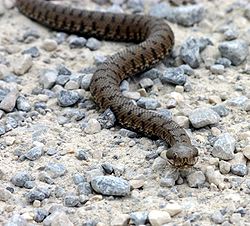.gif)
Asp (reptile)
Encyclopedia

Anglicisation
Anglicisation, or anglicization , is the process of converting verbal or written elements of any other language into a form that is more comprehensible to an English speaker, or, more generally, of altering something such that it becomes English in form or character.The term most often refers to...
of the word aspis, which in antiquity
Ancient history
Ancient history is the study of the written past from the beginning of recorded human history to the Early Middle Ages. The span of recorded history is roughly 5,000 years, with Cuneiform script, the oldest discovered form of coherent writing, from the protoliterate period around the 30th century BC...
referred to any one of several venomous snake
Venomous snake
"Poisonous snake" redirects here. For true poisonous snakes, see Rhabdophis.Venomous snakes are snakes which have venom glands and specialized teeth for the injection of venom...
species found in the Nile
Nile Delta
The Nile Delta is the delta formed in Northern Egypt where the Nile River spreads out and drains into the Mediterranean Sea. It is one of the world's largest river deltas—from Alexandria in the west to Port Said in the east, it covers some 240 km of Mediterranean coastline—and is a rich...
region. It is believed that the aspis referred to in Egyptian mythology
Mythology
The term mythology can refer either to the study of myths, or to a body or collection of myths. As examples, comparative mythology is the study of connections between myths from different cultures, whereas Greek mythology is the body of myths from ancient Greece...
is the modern Egyptian cobra
Egyptian cobra
The Egyptian cobra is a species in the genus Naja found in Africa and the Arabian Peninsula. It is one of the largest Naja species in Africa.- Description :...
.
Throughout dynastic and Roman Egypt, the asp was a symbol of royalty. Moreover, in both Egypt
Ancient Egypt
Ancient Egypt was an ancient civilization of Northeastern Africa, concentrated along the lower reaches of the Nile River in what is now the modern country of Egypt. Egyptian civilization coalesced around 3150 BC with the political unification of Upper and Lower Egypt under the first pharaoh...
and Greece
Ancient Greece
Ancient Greece is a civilization belonging to a period of Greek history that lasted from the Archaic period of the 8th to 6th centuries BC to the end of antiquity. Immediately following this period was the beginning of the Early Middle Ages and the Byzantine era. Included in Ancient Greece is the...
, its potent venom made it useful as a means of execution for criminals who were thought deserving of a more dignified death than that of typical executions. In some stories of Perseus
Perseus
Perseus ,Perseos and Perseas are not used in English. the legendary founder of Mycenae and of the Perseid dynasty of Danaans there, was the first of the mythic heroes of Greek mythology whose exploits in defeating various archaic monsters provided the founding myths of the Twelve Olympians...
, after killing Medusa the hero used winged boots to transport her head to Mount Olympus. As he was flying over Egypt some of her blood fell to the ground, which transformed into asps.
According to Plutarch
Plutarch
Plutarch then named, on his becoming a Roman citizen, Lucius Mestrius Plutarchus , c. 46 – 120 AD, was a Greek historian, biographer, essayist, and Middle Platonist known primarily for his Parallel Lives and Moralia...
(quoted by Ussher
James Ussher
James Ussher was Church of Ireland Archbishop of Armagh and Primate of All Ireland between 1625–56...
), Cleopatra
Cleopatra VII of Egypt
Cleopatra VII Philopator was the last pharaoh of Ancient Egypt.She was a member of the Ptolemaic dynasty, a family of Greek origin that ruled Egypt after Alexander the Great's death during the Hellenistic period...
tested various deadly poisons on condemned persons and animals for daily entertainment and concluded that the bite of the asp was the least terrible way to die; the venom brought sleepiness and heaviness without spasms of pain. The asp is perhaps most famous for its role in Cleopatra's suicide (some believe it to have been a horned viper
Cerastes cerastes
Cerastes cerastes is a venomous viper species native to the deserts of Northern Africa and parts of the Middle East. They often are easily recognized by the presence of a pair of supraocular horns, although hornless individuals do occur. No subspecies are currently recognized.-Description:The...
) as immortalized by both history and legend:
With thy sharp teeth this knot intrinsicate
Of life at once untie: poor venomous fool
Be angry, and dispatch.
- —Cleopatra, Act V, scene II
- Antony and Cleopatra
Antony and CleopatraAntony and Cleopatra is a tragedy by William Shakespeare, believed to have been written sometime between 1603 and 1607. It was first printed in the First Folio of 1623. The plot is based on Thomas North's translation of Plutarch's Lives and follows the relationship between Cleopatra and Mark Antony...
by William ShakespeareWilliam ShakespeareWilliam Shakespeare was an English poet and playwright, widely regarded as the greatest writer in the English language and the world's pre-eminent dramatist. He is often called England's national poet and the "Bard of Avon"...
Othello also famously compares his hatred for Desdemona as being full of "aspics' tongues" in Shakespeare's play Othello. (Act 3, scene iii)

